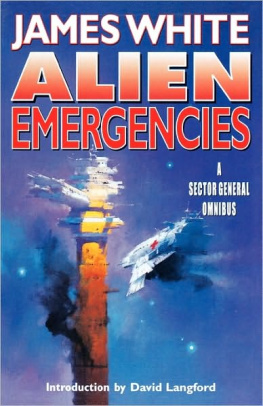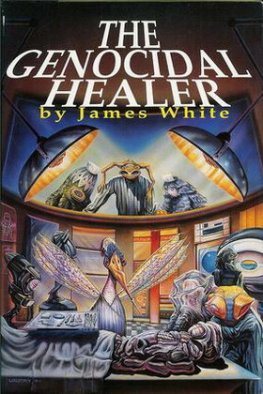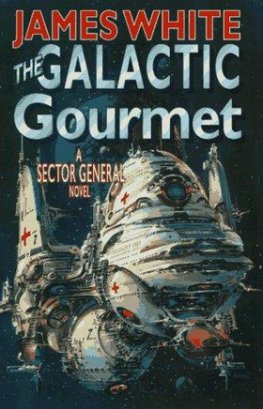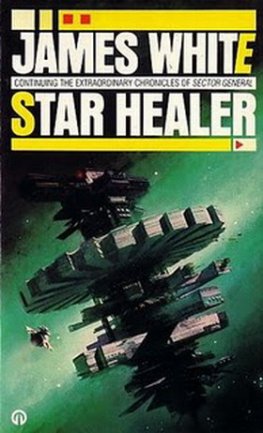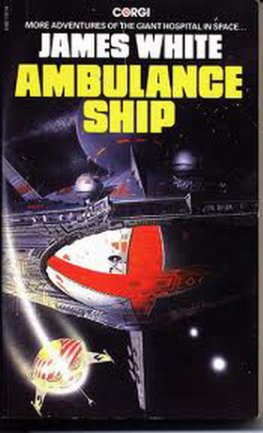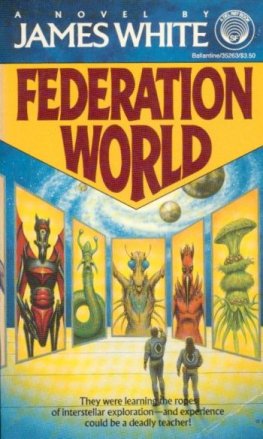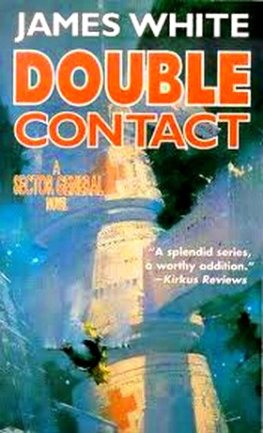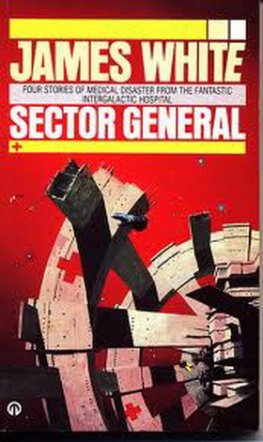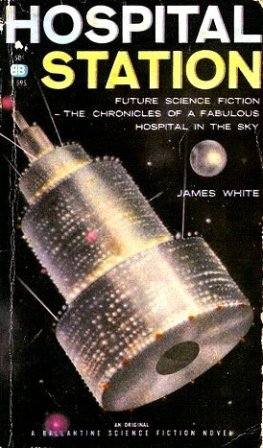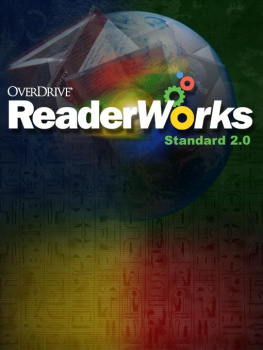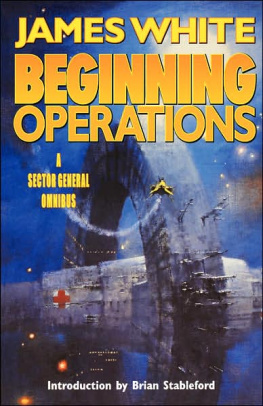Introduction
By David Langford
Sector Twelve General Hospital is one of the most charming and intelligently wish-fulfilling conceptions in science fiction, and its Irish creator James Whitetall, bespectacled, balding, soft-spoken and eternally self-deprecatingwas himself something of a charmer. Not merely a nice man, he was the cause of niceness in others. No one in the SF community could ever dream of being horrid to James.
While others joined literary or fan factions and entangled themselves in heated feuding, James could be found at British conventions solemnly inducting qualified attendeesthose who like himself were several inches over six feetinto the S.O.P.O.A.H. or Society Of Persons Of Average Height. A luckily short-sighted few had the further credentials required for admission to the inner circle, the S.O.P.O.A.H. (W.G.) (With Glasses). Naturally James continued to treat the inner circle, the outer circle and the great unwashed masses beyond with identical benevolence, which somehow lent all those other embattled in-groups the same aura of gentle silliness.
James was and is much loved as a science fiction writer. I fondly remember scouring British bookshops in the 1960s for instalments of his Sector General space-hospital saga, which in those days was appearing in maddeningly brief instalments in E. John Carnells original anthology New Writings in SF , later edited by Kenneth Bulmer. The last to feature there was the first story in this volume, Spacebird from Bulmers New Writings in SF 22 , published in 1973. British fans of Sector General had a long wait for this xenobiological extravaganzas inclusion in the 1980 Ambulance Ship . Americans had to wait longer stilluntil now, in factsince the 1979 US version of Ambulance Ship omitted Spacebird.
As every SF reader should know, Sector Twelve General Hospital is a huge interstellar construction built in a spirit of glorious idealism by many co-operating galactic races, with its 384 levels equipped to simulate the home environment of any conceivable alien patient. Conceivable, that is, to the builders imaginations. From the outset James gleefully harassed his Sector General medics with a steady stream of inconceivables and seeming-impossibles, ranging in size from an intelligent virus and spacefaring barnacles, via beasties without hearts who must keep rolling forever to prevent their circulation from halting, and a levitating brontosaur called Emily, to macro life-forms like the miles-long Midgard Serpent which is discovered scattered through space in dismantled form and must be painstakingly reassembled, or the continent-sized inhabitant of planet Meatball whose treatment in Major Operation requires not so much surgery as military action.
In short, Sector General is the definitive medical SF series. Its precursors include L. Ron Hubbards moderately dire Ole Doc Methuselah stories and the competent hackwork of Murray Leinsters Med Service tales. It may perhaps have helped inspire Piers Anthonys amusing exploits of an interstellar dentist in Prostho Plus . Nothing else in the genre is at all comparable.
To call these stories repeated pattern of medical mystery and elucidation a formula is far from being a put-down. As with detective fiction, the basic pattern offers scope for endless variations limited only by ingenuity and narrative sleight, with Jamess lifelong fascination with medical techniques clearly visible throughout. Theres even room in Sector General for G. K. Chestertons favourite mystery trope of the Happy Surprise, whereby suitable illumination causes sinister and misleading clues to reverse themselves or cancel out, revealing that despite all appearances there has been no crime (or serious threat to health) at all.
Several well-loved props run through the sequence. The most famous is the species classification system which sums up a creatures shape and physiology in four terse letters. Theoretically this coding can extend to many further decimal places, but the first four suffice for practical and narrative purposes. Earth-humans are DBDG and similar warm-blooded oxygen-breathers have similar codes, with teddy-bear Nidians and Orligians also being DBDG while the furry, caterpillar-shaped Kelgians are DBLF. Weirder creatures include chlorine-breathing PVSJs and psi-talented V-codes. One buried joke concerns the unfortunate Gogleskan species of Star Healer , classification FOKT, who are almost unable to prevent themselves from forming mindlessly destructive mobs. This, by intention, greatly tickled the local SF fan group in the traditionally tough city of Glasgow, Scotland: the Friends of Kilgore Trout.
The classification scheme began as homage to E. E. Doc Smiths perhaps unworkably human-centred version from Gray Lensman and Children of the Lens , in which true Homo sapiens is classed AAAAAA while the most alien monstrosities imaginablethe horrid Ploorans in their cryogenic winter metamorphosisregister as straight Zs to ten or twelve places. It is a happy coincidence that Jamess first-ever published words, in his and Walt Williss fanzine Slant 4, were firmly inserted into a contribution that was being horrid to Doc Smith: [These opinions of the great Smith are not those of the typesetter, J. White.]
Nearly half a century later he was honoured with the 1998 Skylark Award, presented by the New England SF Society in memory of Doc Smith and his Lensmen, and so consisting of an absolutely enormous magnifying lens. James found this practical as well as decorative, since by then his sight was failing to the stage where he needed such a glass to read even large type on the computer screen.
Besides demoting humans from AAAAAA to the modest DBDG, James distanced himself in other little ways from the traditional SF anthropocentrism of an era when John W. Campbell still stalked the earth. (It should be remembered that the first Sector General story appeared in 1957.) Smart and sympathetic aliens are foregrounded from the very beginning. Virtually all the hospitals top medical consultants, the eccentric Diagnosticians, are nonhuman. When a roving ambulance ship is introduced, its named Rhabwar after a great doctor from the history of its Tralthan FGLI builders. When Rhabwar s first mission appears to be a simple rescue of boring old humans and someone remarks, There will be no juicy extraterrestrial cases on this trip, he is crushingly answered by a Kelgian nurse: To us, Earth-human DBDGs are juicy extraterrestrials. In three later novels beginning with Code BlueEmergency (1987), the viewpoint characters are aliens who are not only as likeable as the human medics but every bit as accident-prone. Real equality includes the equal right to make blazing mistakes.
Another notable and fruitful series prop is Sector Generals system of Educator tapes, which help prepare doctors for other-species surgery by uploading the skills of an expert from the relevant world. The dark side of this piece of narrative convenience is that a complete and often cantankerous e-t personality is loose in your head, objecting to your vile choice of food (a regular Sector General canteen sight is a Senior Physician eating visually noncontroversial sandwiches of uncertain content, with his eyes tight shut) and possibly imposing strange glandular urges. In the short Countercharm, series hero Senior Physician Conway uses a tape recorded from a randy Melfan ELNT, and finds himself distracted from vital operations by an uncontrollable case of the hots for his gorgeous Melfan pupilwho happens to be a giant crab.

